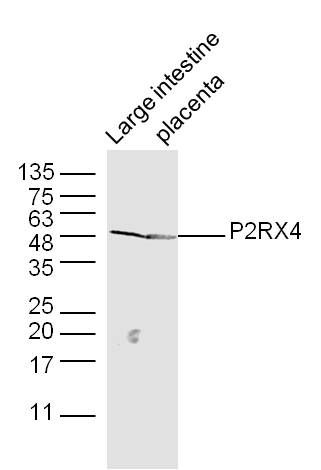P2RX4 Polyclonal Antibody
Purified Rabbit Polyclonal Antibody (Pab)
- SPECIFICATION
- CITATIONS
- PROTOCOLS
- BACKGROUND

Application
| WB, IHC-P, IHC-F, IF, E |
|---|---|
| Primary Accession | Q99571 |
| Reactivity | Rat, Dog, Bovine |
| Host | Rabbit |
| Clonality | Polyclonal |
| Calculated MW | 43 KDa |
| Physical State | Liquid |
| Immunogen | KLH conjugated synthetic peptide derived from human P2RX4 |
| Epitope Specificity | 238-338/388 |
| Isotype | IgG |
| Purity | affinity purified by Protein A |
| Buffer | 0.01M TBS (pH7.4) with 1% BSA, 0.02% Proclin300 and 50% Glycerol. |
| SUBCELLULAR LOCATION | Membrane; Multi-pass membrane protein. |
| SIMILARITY | Belongs to the P2X receptor family. |
| SUBUNIT | Functional P2XRs are organized as homomeric and heteromeric trimers. |
| Important Note | This product as supplied is intended for research use only, not for use in human, therapeutic or diagnostic applications. |
| Background Descriptions | The P2X receptor family is comprised of ligand-gated ion channels that allow for the increased permeability of calcium into the cell in response to extracellular ATP. The seven P2X receptors, P2X1-P2X7, form either homomeric or heteromeric channels or both. They are characterized by intracellular amino- and carboxy-termini. P2X receptors are expressed in a wide variety of tissues, including neurons, prostate, bladder, pancreas, colon, testis and ovary. The major function of the P2X receptors is to mediate synaptic transmissions between neurons and to other tissues via the binding of extracellular ATP, which acts as a neurotransmitter. The P2X receptors may be involved in the onset of necrosis or apoptosis after prolonged exposure to high concentrations of extracellular ATP. |
| Gene ID | 5025 |
|---|---|
| Other Names | P2X purinoceptor 4, P2X4, ATP receptor, Purinergic receptor, P2RX4 |
| Dilution | WB=1:500-2000,IHC-P=1:100-500,IHC-F=1:100-500,IF=1:100-500,ELISA=1:5000-10000 |
| Format | 0.01M TBS(pH7.4), 0.09% (W/V) sodium azide and 50% Glyce |
| Storage | Store at -20 ℃ for one year. Avoid repeated freeze/thaw cycles. When reconstituted in sterile pH 7.4 0.01M PBS or diluent of antibody the antibody is stable for at least two weeks at 2-4 ℃. |
| Name | P2RX4 |
|---|---|
| Function | ATP-gated nonselective transmembrane cation channel permeable to potassium, sodium and calcium (PubMed:9016352). CTP, but not GTP or UTP, functions as a weak affinity agonist for P2RX4 (By similarity). Activated by extracellularly released ATP, it plays multiple role in immunity and central nervous system physiology (PubMed:35165166). Plays a key role in initial steps of T-cell activation and Ca(2+) microdomain formation (By similarity). Also participates in basal T-cell activity without TCR/CD3 stimulation (By similarity). Promotes the differentiation and activation of Th17 cells via expression of retinoic acid-related orphan receptor C/RORC (PubMed:35165166). Upon activation, drives microglia motility via the PI3K/Akt pathway (By similarity). Could also function as an ATP-gated cation channel of lysosomal membranes (By similarity). |
| Cellular Location | Cell membrane; Multi-pass membrane protein {ECO:0000250|UniProtKB:F8W463}. Lysosome membrane; Multi-pass membrane protein |

Thousands of laboratories across the world have published research that depended on the performance of antibodies from Abcepta to advance their research. Check out links to articles that cite our products in major peer-reviewed journals, organized by research category.
info@abcepta.com, and receive a free "I Love Antibodies" mug.
Provided below are standard protocols that you may find useful for product applications.
If you have used an Abcepta product and would like to share how it has performed, please click on the "Submit Review" button and provide the requested information. Our staff will examine and post your review and contact you if needed.
If you have any additional inquiries please email technical services at tech@abcepta.com.













 Foundational characteristics of cancer include proliferation, angiogenesis, migration, evasion of apoptosis, and cellular immortality. Find key markers for these cellular processes and antibodies to detect them.
Foundational characteristics of cancer include proliferation, angiogenesis, migration, evasion of apoptosis, and cellular immortality. Find key markers for these cellular processes and antibodies to detect them. The SUMOplot™ Analysis Program predicts and scores sumoylation sites in your protein. SUMOylation is a post-translational modification involved in various cellular processes, such as nuclear-cytosolic transport, transcriptional regulation, apoptosis, protein stability, response to stress, and progression through the cell cycle.
The SUMOplot™ Analysis Program predicts and scores sumoylation sites in your protein. SUMOylation is a post-translational modification involved in various cellular processes, such as nuclear-cytosolic transport, transcriptional regulation, apoptosis, protein stability, response to stress, and progression through the cell cycle. The Autophagy Receptor Motif Plotter predicts and scores autophagy receptor binding sites in your protein. Identifying proteins connected to this pathway is critical to understanding the role of autophagy in physiological as well as pathological processes such as development, differentiation, neurodegenerative diseases, stress, infection, and cancer.
The Autophagy Receptor Motif Plotter predicts and scores autophagy receptor binding sites in your protein. Identifying proteins connected to this pathway is critical to understanding the role of autophagy in physiological as well as pathological processes such as development, differentiation, neurodegenerative diseases, stress, infection, and cancer.


